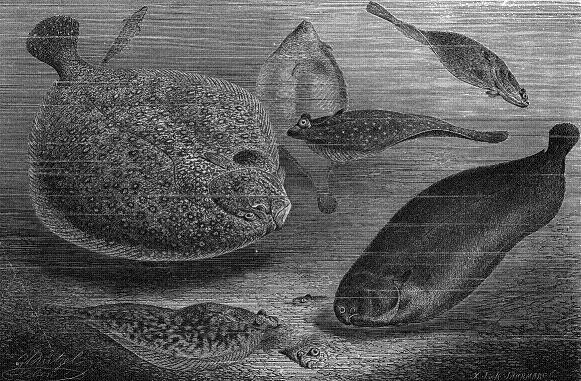Phylogenetics, Systematics, and Bioinformatics
In this lab you'll be exploring the classification of and evolutionary relationships among some odd-looking fish: four species of flatfish (the engraving below shows a few of the species you'll be studying, along with a few more...look for the flatfish hiding on the seafloor!).
Beginning with a published phylogenetic tree that was constructed based on painstaking analyses of flatfish morphology, you will then explore how DNA sequences can be used to evaluate these relationships. First, you'll manually compare some short DNA sequences; then, using full gene sequences, you will use two online tools called Clustal Omega and ClustalW2, developed and hosted by the European Bioinformatics Institute, to conduct a multiple sequence alignment and to derive a type of phylogenetic tree known as a cladogram.
Preparing for the Assignment
In order to complete this assignment, you will need to:
- download the assignment document, a plain-text file called "FishSequences.txt", and the 'ClustalInstructions' PDF from the dropbox for this lab
- review 15.14-15.19 of your textbook for important background information
- update your Java if necessary

Learning Objectives
By the end of this assignment, you should be able to:
1. Use a phylogenetic tree as a hypothesis in order to generate a testable prediction.
2. Align and compare short example DNA sequences and calculate pairwise alignment scores, in order to evaluate the hypotheis.
3. Use an online bioinformatics resource to perform a multiple sequence alignment and comparison and to constructo a phylogenetic tree.
4. Identify similarities and meaningful differences between two phylogenetic trees.
Image Credits
Wood engraving of several flatfish species, from Alfred Edmund Brehm, Illustrirtes Tierleben (1864-1869). [Public domain], via Wikimedia Commons.
Notes
This assignment is based in part upon Gass G, Welsh E. 2011. Lab 7: Phylogenetic trees. BIOL 1010, Department of Biology, Dalhousie University.

